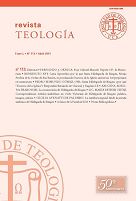Correspondencias estético-simbólicas en Ordo Virtutum de Hildegarda de Bingen: palabra, imagen, música
Keywords:
Hildegarda de Bingen, Místicas y visionarias del siglo XII, Correspondencias simbólicas, Lenguajes estéticosAbstract
Ordo Virtutum is the only dramatic-musical piece composed by Hildegard of
Bingen, usually translated in Spanish as El drama de las Virtudes . Its composition
– in Latin language– dates back to around 1150, during the completion
of her first visionary book, Scivias Domini or Know the ways of the Lord. As
a XIIth century figure with the particular visionary gift and familiarized with
the style of the Scriptures, it is possible to consider that the symbol for Hildegard
has become the most appropriate mode to express herself. In addition,
as mystical woman, the symbolic correspondence of multiple aesthetic lan
guages suggests a creative work in which only one of the expressions would
not have been enough. From the literary field, in dialogue with other arts, this
paper will look at how the symbols from aesthetic languages used by Hildegard
concur and agree, constellated, to broaden the spectrum of meaning of
the play.
Downloads
Downloads
Published
How to Cite
Issue
Section
License














 Teología
Teología